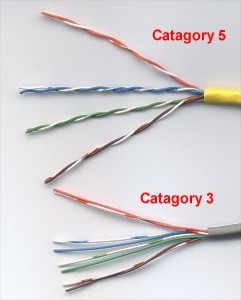 Notice the twists on each pair of wires in the photo. Cat 3 is suitable for telephone lines and 10-base-T networking. You must use cat 5 for 100-base-T networking.
Notice the twists on each pair of wires in the photo. Cat 3 is suitable for telephone lines and 10-base-T networking. You must use cat 5 for 100-base-T networking.
One of the fundamental principles of electricity that makes our world run these days is called induction.
When electricity flows through a wire a magnetic field is set up around the wire. As long as the power is flowing smoothly in one direction, such as from a battery, all that happens is the wire becomes a weak magnet. However, if the flow changes, drops, increases or reverses direction, an interesting property begins to take effect. If you place another wire close to and parallel to the wire carrying the original power, a new electrical flow is induced into the new wire. This is what makes a transformer work.
Telephone wires carry a dc (direct current, steady, in only one direction) current. When you speak, the smooth dc current starts fluctuating, the voltage (electrical pressure) varies rapidly, several thousand times a second.
If all the wires in a phone cable were running straight beside each other, your voice would induce itself onto the other wires. Have you ever heard another person speaking faintly behind your conversation, or if you have 2 phone lines, heard your modem dialing up in the background? This is called cross-talk.
A peculiarity of induction is if the 2 primary wires carrying your voice are twisted, the magnetic field around the wires will be canceled out and there will be little or no induction into any parallel wires. The faster the fluctuation of the current the tighter the wires must be twisted to prevent this induction.
There is actually some induction no matter how tight the wire is twisted. The object is to reduce the cross-talk to the point where you can't hear it, or where 2 network connections don't interfere with each other. Having to make more twists in the wire increases both the amount of copper needed, and the size of the cable. Therefore, we try to use as few twists as possible for any specific application. For the frequencies (speed of fluctuation) needed for voice, a category 3 cable with one twist about every 3 inches is acceptable. The same cable can be used with a 10-base-T (10 megahertz, or 10 million changes a second) network cable. However, if we increase the network speed to 100 megahertz, we need to twist the conductors once every ½ inch to reduce the cross-talk to the point where it won't confuse the network. The newer categories 6 and 6E are basically the same concept, they can simply deal with faster data transfer.
Connection speed is often quite confusing to most people. This confusion comes from the difference in reporting standards. Windows generally talks about file sizes measured in BYTES. Modem manufacturers and Internet providers usually describe their speed in BITS per second.
Think of it this way. You're at the movies and you've got a box of chocolate covered raisins. Just think of this box as a document containing one word, 7 charters long. Your box contains 56 raisins. Each raisin is a BIT in computer terms. When you take a BYTE you are actually eating eight raisins at once. It takes eight BITS (ones and zeros) to make up each charter in the 7 charter word. So in these terms you would eat your entire box in 7 bytes.